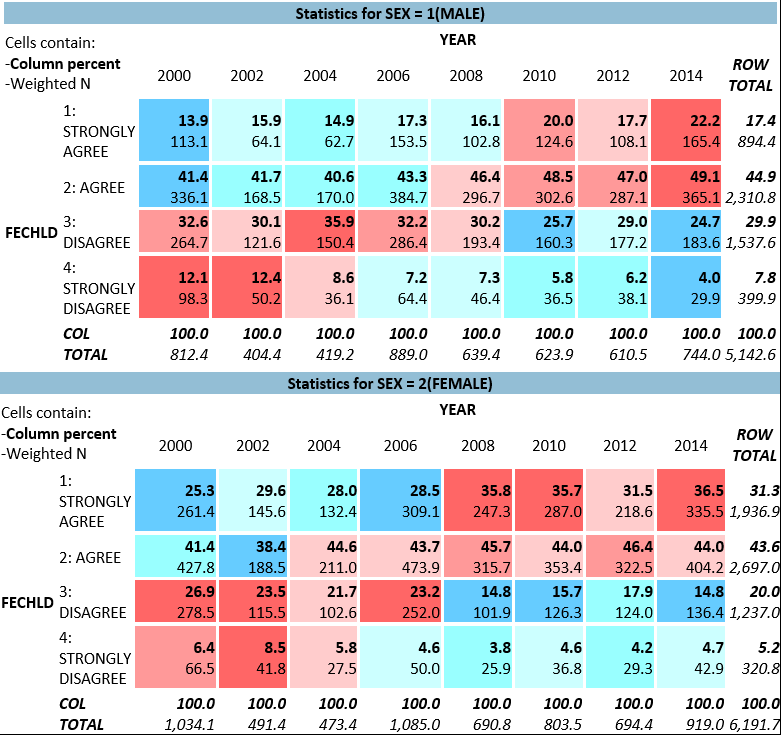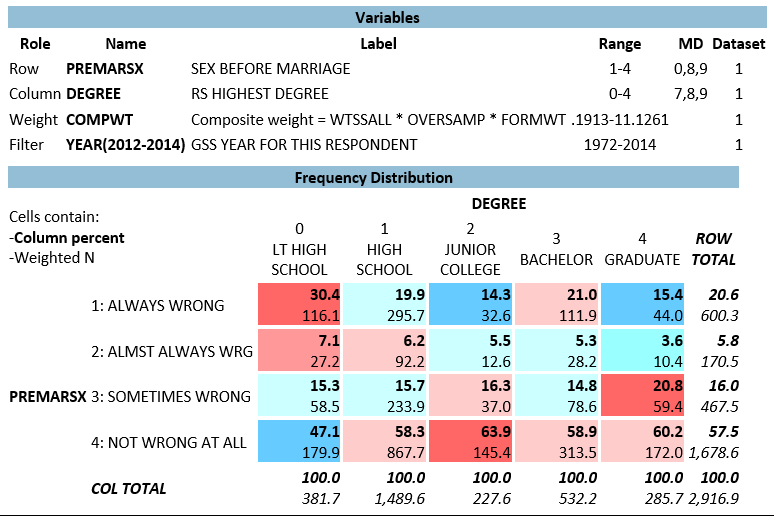Deck 7: Analyzing Inequalities in Families
سؤال
سؤال
سؤال
سؤال
سؤال
سؤال
سؤال
سؤال
سؤال
سؤال

فتح الحزمة
قم بالتسجيل لفتح البطاقات في هذه المجموعة!
Unlock Deck
Unlock Deck
1/10
العب
ملء الشاشة (f)
Deck 7: Analyzing Inequalities in Families
1


-The variable FECHLD is best described as:
A) a dummy variable.
B) a categorical variable.
C) an ordinal variable.
D) an interval-ration level variable.
C
2


-In 2014, the percentage of men respondents who strongly agreed with the idea that mothers working doesn't hurt children was approximately ____ and the percentage of women who strongly agreed with this idea was approximately ____.
A) 22%; 37%
B) 9%; 21%
C) 33%; 52%
D) 15%; 41%
A
3


-In 2000, the modal category for the variable FECHLD among men was ____ and the modal category among women was ____.
A) disagree; agree
B) agree; agree
C) disagree; strongly agree
D) agree; strongly agree
B
4


-In 2014, the modal category for the variable FECHLD among men was ____ and the modal category among women was ____.
A) disagree; agree
B) agree; agree
C) disagree; strongly agree
D) agree; strongly agree

فتح الحزمة
افتح القفل للوصول البطاقات البالغ عددها 10 في هذه المجموعة.
فتح الحزمة
k this deck
5


-Which of the following statements is true, based on the information presented in Figure 7.1?
A) For both men and women respondents, most disagree with the idea that "A working mother can establish just as warm and secure a relationship with her children as a mother who does not work"
B) From 2000 to 2014, the percentage of men who strongly agreed with the idea that "A working mother can establish just as warm and secure a relationship with her children as a mother who does not work" has generally decreased.
C) In 2014, the percentage of women who either disagreed or strongly disagreed with the idea that "A working mother can establish just as warm and secure a relationship with her children as a mother who does not work" was higher than the percentage of men who either disagreed or strongly disagreed with this idea.
D) In 2014, the percentage of women who strongly agreed with the idea that "A working mother can establish just as warm and secure a relationship with her children as a mother who does not work" was higher than the percentage of men who strongly agreed with this idea.

فتح الحزمة
افتح القفل للوصول البطاقات البالغ عددها 10 في هذه المجموعة.
فتح الحزمة
k this deck
6


-The variables FECHLD, YEAR, and SEX have all been included in the GSS regularly since 1977. If the researchers removed the FILTER used to create Figure 7.1, and then re-ran the analyses, what would happen to the overall number of cases in the analysis?
A) The number of cases would likely decrease.
B) The number of cases would likely increase.
C) The number of cases would likely remain the same.

فتح الحزمة
افتح القفل للوصول البطاقات البالغ عددها 10 في هذه المجموعة.
فتح الحزمة
k this deck
7

-The variable PREMARSX is best described as:
A) a dummy variable.
B) a categorical variable.
C) an ordinal variable.
D) an interval-ration level variable.

فتح الحزمة
افتح القفل للوصول البطاقات البالغ عددها 10 في هذه المجموعة.
فتح الحزمة
k this deck
8

-In general, as educational attainment increases, the percentage of people who believe that premarital sex is "always wrong":
A) increases
B) decreases
C) stays about the same

فتح الحزمة
افتح القفل للوصول البطاقات البالغ عددها 10 في هذه المجموعة.
فتح الحزمة
k this deck
9

-Compared with respondents who have less than a high school education, those with a high school diploma are ____ to believe that premarital sex is "not wrong at all."
A) more likely
B) less likely
C) equally likely

فتح الحزمة
افتح القفل للوصول البطاقات البالغ عددها 10 في هذه المجموعة.
فتح الحزمة
k this deck
10

-Which of the following statements best describes the modal response category?
A) At every level of educational attainment, the modal category is "always wrong."
B) At every level of educational attainment, the modal category is "not wrong at all."
C) At every level of educational attainment, the modal category is "almost always wrong."
D) The modal category for premarital sex changes depending on respondents' educational attainment.

فتح الحزمة
افتح القفل للوصول البطاقات البالغ عددها 10 في هذه المجموعة.
فتح الحزمة
k this deck








